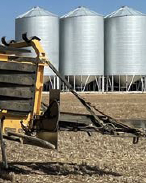This article is 7 years old. Images might not display.
David Hall, Western Australia Department of Primary Industries and Regional Development (DPIRD) said while farmers have been very good at creating maps showing one constraint or another, researchers are now showing that many soils have multiple constraints which often need to be managed together as opposed to separately.
"Where we thought that soils were being limited by acidity, for example, we have now found that those soils may also be compacted," David said.
"The question then is what sort of soil amendments or amelioration are most economical to apply to remedy the problem."
Teasing out answers to this complex question is at the heart of a five-year GRDC-funded project investigating subsoil constraints in the Western Australian grain belt. The project, delivered by DPIRD and CSIRO, has three components - an economic analysis of the costs and economic impact of subsoil constraints; mapping, to understand the extent of the problem and create detailed maps of subsoil constraints across the WA grainbelt; and an on-ground component investigating the likely responses of different approaches to ameliorating constraints.
The study began in 2014 and the first component of it, a scoping study of what is known about constraints and the economic impacts of those constraints, was completed early last year and reported in Farming Ahead February 2016. Subsoil acidity alone was found to cost WA grain growers an average of $141/ha/year or a total $1.6 billion/year in lost production (Table 1).
MULTIPLE CONSTRAINTS
The research team has now mapped subsoil constraints across the WA wheatbelt and the maps show that in many areas, there are multiple constraints.
"We've previously thought it possible to work to ameliorate the most limiting constraint, but what if acidity and compaction are all equally limiting?" David said. "What is the best approach then?
"We are seeing this sort of situation on some of the sandy earths in the wheatbelt. In some of these soils, severe compaction is probably as big an issue as acidity. This means that addressing the compaction alone would not mitigate the subsoil constraints."
David said that this and similar situations could lead growers to think that the amelioration they had applied to their soils hadn't worked, because they hadn't seen a subsequent increase in yield, but in fact what was happening was that with only one constraint mitigated, any other constraint is still limiting productivity.
David said that currently available diagnostics are often insufficient to enable growers to confidently identify and manage all subsoil constraints.
"Confidence in predicting the severity and extent of these constraints is important given that many farmers are experiencing reduced margins due to drying climates and increasing costs relative to returns," he said.
"From our on-ground research work we are gaining an understanding of what the limitations are and how they combine."
BETTER MAPPING
"Our abilities to map constraints are limited," David said. "Generally, we rely on collecting two or three soil samples per paddock, but we may have different soil types across that paddock, and they would respond differently to amelioration. So, we are trying to create more detailed mapping at sub-paddock scales using geophysics, EM and Gamma mapping to gain a better understanding of what's going on."
David said this is by far the most challenging aspect of the project intellectually, with significant effort going in to creating the mathematical models and algorithms to get something that works.
"We've looked at detailed data from specific areas and related that to mathematical models. We've needed particularly good datasets to underlie this and to identify what constraints are happening at a paddock level, and have had valuable input from agronomy consultants."
WORKING OUT THE BEST APPROACH
"Very few farmers have enough spare cash to do everything to ameliorate all the constraints across the farm," David said.
"Our aim is to determine the best place to make amendments to give the biggest return. What soils are going to get the best return on soil amelioration?"
To this end, the researchers have created a spreadsheet, titled ROSA (Ranking Options for Soil Amendments), that is currently being ground-truthed. The plan is to release this tool as a spreadsheet first, and subsequently as a mobile or web-based app, to help growers make decisions about the best way to overcome soil constraints on their properties.
The aim is to create a tool that enables growers to feed in information about their property, pH and other soil test results, along with rainfall and cropping data, and obtain recommendations for soil amendments. At this stage the project is limited to Western Australia, but researchers elsewhere are ‘watching this space' with interest.
"Our aim is to have something working and with WA growers early in 2018, before sowing begins for the season," David said. "The spreadsheet form that we currently have seems to be working well in the areas where we've tested it.
"Some of the soils we're looking at have been considered poor. Our aim is to understand how these limitations can be managed profitably across all seasons."
Contact:
David Hall, DPIRD
08 9083 1111
GRDC Project DAW00242






















